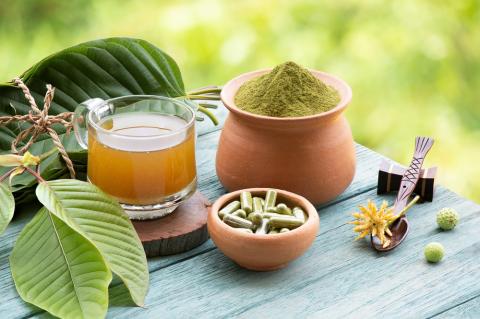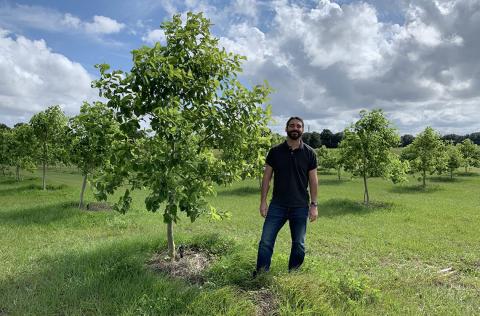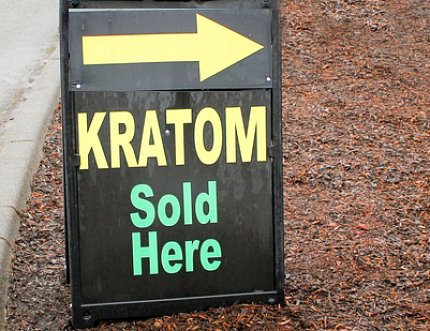‘Complex Symphony Orchestra’
McCurdy Studies Whether Kratom Can Reduce Opioid Withdrawal, Ease Pain

It’s a word now commonly spotted on smoke, vape and herbal shop signs across much of the country. But what exactly is kratom and is it safe to ingest?
Kratom is a tropical evergreen tree, from the same family as the coffee plant, whose leaves can be consumed in various forms. Its active compounds reportedly produce a range of stimulant, pain-relief and mood-enhancing effects.
Dr. Christopher McCurdy, professor of medicinal chemistry at the University of Florida (UF), became interested in the therapeutic potential of kratom from learning how it’s been used in its native region.
“Kratom has been used by field workers in Southeast Asia to relieve pain and as a stimulant to improve their work capacity in the hot, tropical climate,” he said. “Also, when they would run out of opium—for those who used it—they would use kratom in a little bit higher doses to help avoid opioid withdrawal.”
McCurdy wants to get to the root of the leaves’ chemical properties and pharmacologic effects. He asks, as does the title of his recent NCCIH Integrative Medicine Research Lecture, “Can a controversial tree help end the opioid crisis?”
Drug of Concern

Photo: WASANAJAI / SHUTTERSTOCK
Despite an FDA import alert, an estimated 2,000 metric tons of kratom enter the U.S. monthly, mostly from Indonesia, suggesting millions of users across the country. Though federally legal, kratom is banned or restricted in multiple states. The U.S. Drug Enforcement Administration has classified kratom as a drug and chemical of concern, pending further study.
“We know that very few deaths are attributable to a kratom product alone, and for those that are, there could be extreme circumstances, in terms of overdosing, or it could be adulterated with synthetic compounds,” such as fentanyl derivatives or other novel psychoactive substances that are unknown or undetected, said McCurdy.
Traditionally, in Thailand and elsewhere in Southeast Asia, kratom is consumed as a brewed tea. The fresh leaves are cut and boiled for hours.
In the U.S., though, kratom arrives as crushed leaves or powder and can come in different forms: capsules, energy shots, even gummies. McCurdy is collaborating with UF’s Apopka campus to grow kratom trees and extrapolate the pharmacologic differences between fresh-leaf kratom and concentrated extracts.
“Collaboratively, we are trying to get a homegrown species to develop a product more similar to the traditional use for study in the U.S., [rather] than having to rely on these dried-leaf materials, which undergo post-harvest oxidation…and many times have changed the composition of the alkaloidal content,” he said.
Therapeutic Potential

Photo: courtesy of Brian Pearson
Kratom has opioid activity, said McCurdy, “but I’m going to show you that it’s much more disruptive than just opioid activity. We’ve looked at it primarily as having the potential to replace several medications used during opioid detoxification.”
McCurdy points to kratom having adrenergic (stimulant); serotonergic (mood-enhancing); analgesic (pain-relieving) and anxiolytic (anti-anxiety) activity. “If you could combine all those into one product,” he said, “you might be able to improve medication adherence and completion of detoxification.”
Another plus is that traditional kratom withdrawal tends to be mild. “It’s in the upper end of mild,” McCurdy said, “but it’s not in moderate and it’s certainly not in severe.” He’s working to get a standardized kratom product into clinical trials to evaluate its overall potential and therapeutic claims.
The Abundant Alkaloid
So far, investigators have isolated more than 40 alkaloids—organic compounds—in kratom. The predominant one, mitragynine (MG)—which gets its name from the plant’s genus, Mitragyna speciosa—accounts for up to 66 percent of kratom’s alkaloid content.
“It’s the most abundant alkaloid in the plant, so it’s the most easily extracted, isolated, purified and studied,” said McCurdy.

MG occurs naturally in the plant. It’s considered a partial opioid receptor agonist, though McCurdy said he wouldn’t lump it in the traditional opioid category.
“We’ve collected data to show it has much less abuse and dependence liability than other opioid analgesics,” he said.
What’s more, MG’s chemical composition pushes away some adverse side effects of traditional opioids, such as constipation and respiratory depression. “If you look at poison control center data,” he added, “kratom overdoses resemble stimulants, not opioids.”
In wild-type mice injected with a large dose of MG, McCurdy said the analgesic effect comes quickly, then dissipates after an hour. But this is just MG isolated.
“Kratom is a complex symphony orchestra of alkaloids, and what we generally tend to do in science is pluck each instrument out and listen to it at full blast and forget about the symphony it naturally occurs in,” said McCurdy, urging listeners to take the data he presented in that context. “We’re looking at these [elements] at full blast. These are big doses [given to the mice]…To achieve that in humans taking kratom just straight, it would make them vomit long before they would get to that level of efficacy.”
Ingesting kratom whole, through the tea leaf, has good analgesic effects but is less robust than taking straight mitragynine orally, which can be as potent as codeine or morphine in some cases.
“MG by itself is that loud trumpet it wants to be,” he said. “It does not appear to have abuse or addiction potential and reduces morphine and heroin intake in rats. These are of course desired characteristics of candidate pharmacotherapies for opiate addiction and withdrawal.”
Molecule of Concern
One of the three known unnatural alkaloids in kratom, 7-hydroxymitragynine (7-HMG), can form when drying the leaves and it also metabolizes in the body. Not seen in fresh-leaf kratom, 7-HMG has high selectivity at opioid receptors.
“That’s why we’re so concerned about this molecule,” said McCurdy.

Photo: The Image Party / Shutterstock
He said his studies found 7-HMG “more potently substitutes for morphine…indicating that 7-hydroxy is potentially an abusable and addictive compound.”
However, 7-HMG is unstable in human plasma and, taken orally, it does not appear to cross the blood-brain barrier very efficiently. New research shows equally promising news about the amount of MG converted to 7-HMG in the body.
“This is some of the hottest new data, refuting some work that’s come out saying that 7-hydroxy is responsible for kratom’s analgesic effects,” McCurdy said. “We don’t believe that to be the case. We don’t believe the amount generated through metabolism is pharmacologically relevant.”
McCurdy’s research to date suggests kratom could help curb the opioid epidemic and manage pain and has other potential applications yet unexplored.
“There’s so much anecdotal evidence out there in treatment of cardiovascular disease, diabetes and other avenues we haven’t been able to tread into yet,” he said during the Q&A. “Legitimate users are fighting to keep kratom legal; it’s revolutionary for them.”
